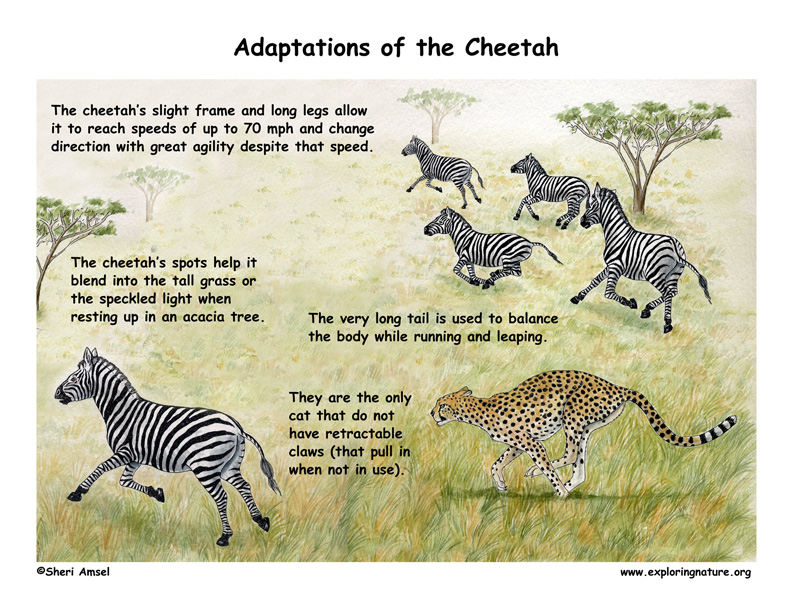

Adaptation in a population of living things happens as a result of an adaptive trait. This is any inheritable trait that increases its survival rate so that it can live longer, reproduce longer, and have more offspring (that also have that trait). Adaptive traits can improve an animal's ability to find food, make a safer home, escape predators, survive cold or heat or lack of water.
The cheetah is thought to be the fastest land animal in the world. It can reach speeds of up to 70 mph (112 kph) in short spurts while chasing prey. This speed is a result of several adaptive traits working together. They have a slight frame and long legs that not only help with speed but also agility during a chase. Their agility allows them to change direction quickly to follow running prey.
Their spots act as camouflage while they wait in the tall grass or perched up high in the dappled light of an acacia tree. Their very long tail helps with balance when they run and leap. They are also the only cat without retractable claws, so perhaps digging in with their claws is another factor in their running abilities. All of these are physical adaptations that help make the cheetah a successful predator on the African savannah.
For Discussion and Critical Thinking:
The cheetah has adaptive traits that help it hunt and catch prey, reproduce and compete with other predators out on the African savannah.
1. Besides for speed, what other adaptive traits help the cheetah successfully catch its prey?
2. Can you think of other animals that use their speed to survive? Name two and how their speed helps them.
3. Two big cats – the lion and cheetah both survive on the savannah together. What is different about the way they hunt that allows them to live in the same niche?
4. How do you think a cheetah would do in a forested habitat? How would its adaptive traits for the savannah help or hinder its success in this other habitat?
When you research information you must cite the reference. Citing for websites is different from citing from books, magazines and periodicals. The style of citing shown here is from the MLA Style Citations (Modern Language Association).
When citing a WEBSITE the general format is as follows.
Author Last Name, First Name(s). "Title: Subtitle of Part of Web Page, if appropriate." Title: Subtitle: Section of Page if appropriate. Sponsoring/Publishing Agency, If Given. Additional significant descriptive information. Date of Electronic Publication or other Date, such as Last Updated. Day Month Year of access < URL >.
Amsel, Sheri. "Adaptations of the Cheetah" Exploring Nature Educational Resource ©2005-2024. December 13, 2024
< http://www.exploringnature.org/db/view/Adaptations-of-the-Cheetah >

